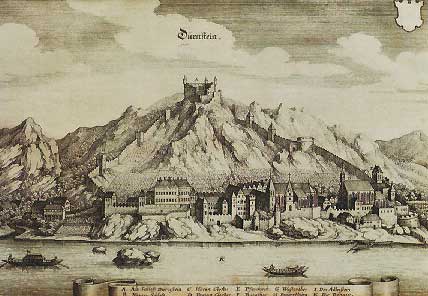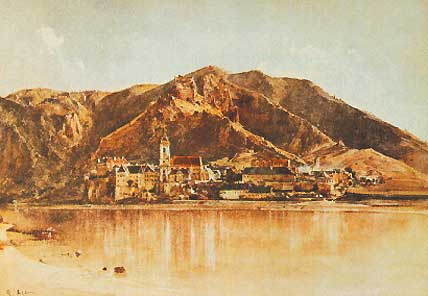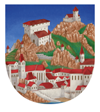History
During the 11th century, the Kuenring family came to Austria from the Bavarian-Saxon region and were given large territories near Eggenburg and Gobelsburg as an imperial fiefdom.
In the service of the local Austrian Babenberger prince, they acquired a sizable portion of the Waldviertel in Lower Austria. The Tegernsee Monastery in Bavaria appointed them as bailiffs in the Wachau to guard over the possessions that belonged to the monastery.
Asso von Kuenring acquired the region around present-day Dürnstein, and his grandson, Hadmar I, was the first to create a fortress on the cliffs above the Danube.
In 1192/93, the English King, Richard I (Richard the Lionheart), was held prisoner in the Kuenring Castle by order of the Babenberger Leopold V. A share of Richard’s ransom, that fell to the Kuenring family, was used for the expansion and renovation of the castle and the village of Dürnstein in the 13th and 14th centuries.
In 1347, the estate was divided between the Kuenring brothers Leuthold II and Johann I, and the new village settlement was denoted a city for the first time. In this year, Dürnstein was granted legal status as a municipality by Johann I, and the inhabitants were called citizens.
However, the city of Dürnstein did not receive its coat of arms until 1476, awarded by Emperor Friedrich III.


Important History data of Dürnstein
1002 Emperor Heinrich II, "The Saint", bestowed upon the Tegernsee Monastery 2 wooden cabins located in Liupna (Loiben) between Watstein and Holinstein within the lands of Heinrich I.
1019 Confirmation of the bestowal by Emperor Heinrich II with an exact description of the area. The Kuenring family, who were rural nobility, immigrated from the Bavarian-Saxon region. Construction of the castle 1246, followed by the reconstruction of Dürnstein Castle in 1255.
1050 Asso von Kuenring is the first bailiff to the Tegernsee Monastery. With the death of Leuthold v. Kuenring on 4 August 1355, the Kuenring-Dürnstein family line dies out with its last male member. After the family Kuenring, the Mastery of Dürnstein is passed on to the Masters of Maissau, then to Duke Albrecht, followed by Ulrich v. Eitzing, and in 1609 to the Masters of Zelking.
1192 The name "Dürnstein" is mentioned for the first time when Richard the Lionheart is held prisoner from 21 December 1192 until March 1193. With the largest share of the ransom – 100.000 silver marks – the town of Wiener Neustadt was built. Hadmar II led the noble prisoner up to Dürnstein Castle.
1347 On the 1 September, Dürnstein is referred to as a city for the first time in the Kuenring’s family certificate of inheritance.
1476 The citizens of Dürnstein ask Emperor Friedrich III for the right to use the image of the city as their coat of arms; he responded to the request and imparted a grant of arms with a beautiful depiction of their city.
1477 and 1485The capture of Dürnstein by the Hungarians under Mathias Corvinus.
1492 On 14 July Emperor Friedrich confirms the judge of Linz, and grants the council and citizens of “Tiernstain” municipal law.
1551 A fire destroys the entire city. It takes 10 years for the citizens of Dürnstein to rebuild the city using the regional taxes of the Wachau.
1645 The demolition of Dürnstein Castle by a blast carried out by the Swedes under General Torstenson.
1683 13 September: In Dürnstein, Emperor Leopold I receives the message that Vienna has been freed from the Turkish occupation from the young Count of Auersperg.
1741 Threat of war by Bavarian-French troops.
1805 Battle of Loiben and Dürnstein.
1850 The Mayor takes office in Dürnstein. Up until then, a judge was elected by the citizens every two years under the Chairman of the Guards. The first Mayor was Franz Xaver Schendl.
1872 Founding of the volunteer fire brigade.
1902 Opening of the steamship station.
1906 Construction of a modern mountain-spring water supply line.
1909 The Wachau-Railway is built. 3.675 kg of dynamite are used to demolish rock masses at Vogelberges by Archduke Franz Ferdinand.
1925 Major fire in Dürnstein.
1968 The communities of Oberloiben and Unterloiben are merged into one.
1971 The community of Loiben is joined with Dürnstein.
1994 The European Diploma for Protected Areas is awarded.
2001 Appointment of Wachau as World Cultural Heritage.
2002 Loiben – 1000-year anniversary.
 Dürnstein
Dürnstein